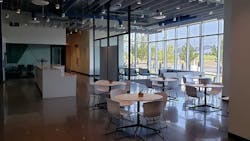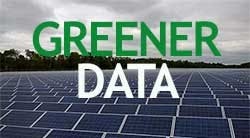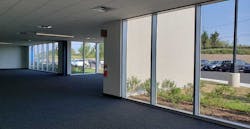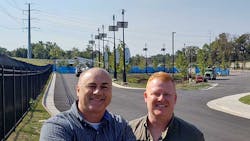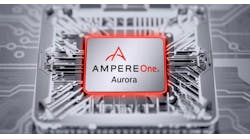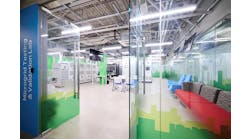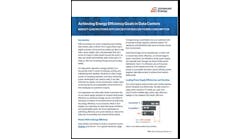Sustainable by Design: Vantage Adds Green Features in Northern Virginia
This is the first in an ongoing series titled “Greener Data” which will explore the data center industry’s progress on sustainability.
ASHBURN, Va. – Does office space matter when large tech companies are shopping for data center space? How about the environmental profile of the building and campus, as well as the utility power and data hall?
A growing number of data center providers are taking a holistic view of data center design and operations, as they work to deliver environments that work for customers on every level. An example of this is Vantage Data Centers’ VA11 facility in Northern Virginia, which the company describes using phrases like “A Data Center You Love to Be In” and “Sustainable by Design.”
It’s an experience that begins in the parking lots, featuring outdoor lighting powered by on-board solar panels and wind turbines, along with a solar array on the front lawn, and charging stations for electric vehicles.
It continues inside the building, with spacious, sunlit customer lounges. A large break room features floor-to-ceiling windows, with comfortable couches and chairs filling the seating area, a ping pong table and Ms. Pac Man machine for entertainment, multiple refrigerators, a locker room and shower area, and a choice of small or large conference rooms for business meetings.
“We put in a lot of things to make this a nice place to work,” said Lee Kestler, the Chief Commercial Office for Vantage.
Vantage is distinctive in how it incorporates sustainability throughout its design, an approach that reflects the priorities of a growing number of data center customers – especially the large enterprises and hyperscale customers that are the leading tenants for wholesale data center providers like Vantage.
Customer areas are part of that evolution of mission-critical design. Engineering for reliability and efficiency will always be the prime directive in data center design, along with business models that seek revenue from every available square foot of a building.
That was certainly true in the early days of the industry, when staffers working in the data center might operate from small windowless offices, card tables and folding chairs inside customer cages, or even “crash carts” accessing servers via KVM (keyboard, video and mouse) switches in the rows between racks of gear.
Office Space as a Differentiator
That’s no longer the case, and Vantage has been one of the providers responsible. Since its launch in 2011, Vantage has created corporate amenities in its data centers, similar to a comfortable Class A office-like setting. The company sees data centers as “highly functional business facilities,” and its early projects in Santa Clara marketed offices and conference rooms as a selling point for companies transitioning from in-house data centers to third-party facilities.
Other providers have joined Vantage in placing higher priority on tenant areas. Companies like Switch and RagingWire have raised the bar for comfort and design in office space and conference rooms, while Google and Facebook have created hip, open office areas for admin teams at their hyperscale campuses.
If these large companies want comfortable work spaces for their own data centers, it makes sense that they would like similar environments in their leased facilities. Another factor is that more data center operators are opening their facilities to the public for tours and events, an effort reflected in initiatives like next week’s International Data Center Day.
An office space for future customer use at the Vantage VA11 data center. (Photo: Rich Miller)
The VA11 building was designed with office space around the outside, allowing Vantage to create sunny spaces to offer workers an escape from the cool, loud and often dark aisles of the data hall. Dedicated offices, break rooms and and workspaces can be customized for individual customers
Vantage says that provider a superior environment for customers can be a differentiator, particularly in a competitive market like Northern Virginia. “We know that our customers spend a lot of time in the data center, and having space to work, relax and recharge is essential,” said Vantage.
The “recharge” theme is prominent at VA11. The outdoor lighting is mounted on 19 poles that are each equipped with a rotary windmill on top a small solar panel, illuminating the parking area and building exterior with clean power. The light poles provide nearly 4,000 kilowatt hours (kWh) per year of renewable energy.
A multi-tier “solar tree” array of photovolatic panels provides 4,788 kilowatt hours of clean power annually for the building’s office areas. The front parking area includes multiple charging stations for electric vehicles, with a choice between solar or utility power.
Vantage Data Centers’ Chief Commercial Offier Lee Kestler (left) and VP of Marketing Mark Freeman (right) at the company’s new VA11 data center in Ashburn, Virginia, with the facility’s renewably-powered light poles. (Photo: Rich Miller)
Vantage says the solar tree array will save 3.30 metric tons per year of CO2 emissions from entering the environment. One solar tree can power an electric vehicle for nearly 16,000 miles per year, or charge approximately 500,000 smart phones per year.
Vantage Building Coast-to-Coast
The first phase of VA11 offers six megawatts of data center space, with another 24 megawatts to follow in subsequent phases. It is the first of five buildings and 142 megawatts of capacity planned for Vantage’s Northern Virginia project. The campus features a new design using air-cooled chillers, which dramatically reduce the data centers’ use of water – while also helping Vantage deliver efficiency as measured via PUE (Power Usage Effectiveness) and WUE (Water Usage Effectiveness).
A data hall in the Vantage Data Centers campus in Ashburn. (Photo: Rich Miller)
The new data center has robust fiber connectivity and an N+1 redundant power infrastructure, supported by a bank of 2.75-megawatt backup generators. Equipment for cooling and power distribution is housed in equipment galleries that are isolated from the data halls.
The Ashburn project is just one component of an expansion strategy that has kicked into high gear in 2019. Late last year, Vantage acquired Canadian provider 4Degrees Colocation, providing a data center footprint in the power-rich market in Quebec. Earlier this year, Vantage unveiled plans to build a 1 million square foot data center in Goodyear, Arizona to serve the fast-growing Phoenix market and lined up $675 million in debt and equity financing to fund its growth.
Vantage’s coast-to-coast presence in North America now spans six markets, including U.S. campuses in Santa Clara, Northern Virginia, Phoenix and Quincy, Washington as well as campuses in Montreal and Quebec City in Canada.
The campus features a new design using air-cooled chillers, which dramatically reduce the data centers’ use of water – while also helping Vantage deliver efficiency as measured via PUE (Power Usage Effectiveness) and WUE (Water Usage Effectiveness).
The new data center has robust fiber connectivity and an N+1 redundant power infrastructure, supported by a bank of 2.75-megawatt backup generators. Equipment for cooling and power distribution is housed in equipment galleries that are isolated from the data halls.

